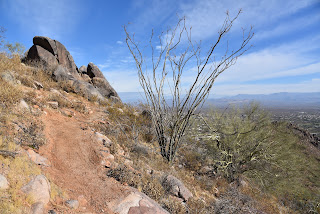HEIFER PASTURE
 |
| Birds flock above the Heifer Pasture well site |
The first bird barely caused a stir. The single white-crowned sparrow alighted on a winter-bare mesquite branch, ruffled its wings and turned against the whipping prairie wind. Moments later, a house finch with brilliant red chest plumage landed on the opposite end of the branch, initiating a sort of see-saw balancing act with its smaller companion. Then, in a flurry, there were dozens. The mesquite tree was flush with birds hanging on every twig, sitting silently waiting for who knows what.
 |
| Estler Peak (left) and Bradshaw Mountains |
The scene repeated on nearby junipers and catclaw shrubs. Hundreds of birds alternately flocking, flying and perching on the sparce vegetation of Heifer Pasture.
 |
| Cattle gather at Heifer Pasture well |
Their sheer numbers and propensity to congregate in large groups near where I was hiking teased of a crux moment in a Hitchcock film or maybe a nefarious carcass lying unseen in the drainage that paralleled my route. Clearly, my film noir addiction muddled my perception, for birds behaving like this is the natural way of things on the high grasslands of Prescott National Forest.
 |
| The hike follows Forest Road 9650R |
Heifer Pasture is a quiet place. Other than the rustling of feathers and bellows of domestic cattle the stretch of hilly rangeland 3 miles east of Interstate 17 is as silent and peaceful and its pastoral name implies.
 |
| Heifer Pasture well attracts wildlife and cattle |
 |
| Birds perch in mesquites at Heifer Pasture well |
The pasture can be explored by way of a maze of forest roads that are used by ranchers, equestrians and ATV riders. But the rough dirt two-tracks are also great for hikers who appreciate solitude, far-reaching vistas and lots of avian company. One easy route is Forest Road 9650R which spins off Dugas Road north of Cordes Junction. Flanked by the imposing pinnacle of Estler Peak to the west and a bank of volcanic bluffs and mesas to the east, the road embarks on a mild uphill climb through breezy savannah dotted with low-growing trees and shrubs.
 |
| A white-crowned sparrow rests on a shrub |
At the 0.4-mile point, veer right at a major junction, pass an old gate and follow the disintegrating track northeast as it makes its way toward Heifer Pasture Well. The 262 feet of elevation gain on this segment is barely noticeable, but as the vegetation gives way from scrub to yucca and cacti, views of the Bradshaw Mountain range to the west begin showing up in majestic style. At the high point of the hike, the road is smothered in acres of knee-high, golden grasses. From this vantage point, the sliver of Interstate 17 cutting through mountain passes is evident only by the glint of passing big rigs and motor homes.
 |
| Bradshaw Mountains views doom FR 9650R |
 |
| Rustic gate on FR 9650R |
Off to the west, sunlight bounces off the blades of the Heifer Pasture Well windmill that’s tucked into a cleft between two prominent buttes. The road makes a sharp bend and comes to a gate near Black Butte Tank which was dry on my recent visit. The gate is secured with a rope and must be closed after passing through.
 |
| Bucolic scene at Heifer Pasture well |
A few yards beyond the tank, the creaky windmill pumps groundwater into a metal stock tank where cattle lap their fill and graze the collection of feed tubs scattered about.
 |
| Domestic cattle roam in Heifer Pasture |
The birds found this place too. Attracted by the water and free buffet, hundreds of birds of species beyond my identification skill set congregate in this idyllic setting. Their fluid areal displays are worth hanging around to witness.
 |
| Black Butte tank near Heifer Pasture well |
Forest Road 9650R continues on beyond the well, passing corrals and more tanks before connecting with the Great Western Trail. If you want to add miles to this scenic trek, consult the Prescott National Forest map to see the many connecting routes and exploratory options nearby.
 |
| Entry gate at Heifer Pasture well site |
LENGTH: 3.6 miles roundtrip to the well and back
RATING: easy
ELEVATION: 3,889 – 4,151 feet
GETTING THERE:From Interstate 17 north of Cordes Junction, take exit 268 for Orme/Dugas Road. Turn right at the bottom of the offramp and go 3.5 miles on Dugas Road (County Road 171) to Forest Road 9650R on the left. Park in the turnouts a few yards in. Dugas Road is maintained dirt suitable for all vehicles.















































